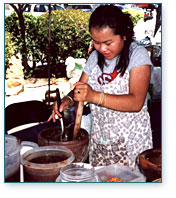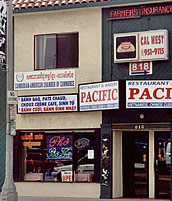Continued from page 1
 Others work in service sector industries, especially in ethnic enclaves, as store clerks, restaurant servers, or dishwashers. Some work as janitors and gardeners in the mainstream economy. Employers, including co-ethnic employers, sometimes exploit refugees and immigrants who may be unfamiliar with workplace policies and less likely to complain about unfair working conditions. Nevertheless, some Southeast Asian factory workers and service sector employees have been involved in union organizing, ensuring that they are treated fairly in the workplace, and are even forming alliances with workers of other ethnic and racial backgrounds. Others work in service sector industries, especially in ethnic enclaves, as store clerks, restaurant servers, or dishwashers. Some work as janitors and gardeners in the mainstream economy. Employers, including co-ethnic employers, sometimes exploit refugees and immigrants who may be unfamiliar with workplace policies and less likely to complain about unfair working conditions. Nevertheless, some Southeast Asian factory workers and service sector employees have been involved in union organizing, ensuring that they are treated fairly in the workplace, and are even forming alliances with workers of other ethnic and racial backgrounds.
Women
Southeast Asian women worked in both family labor and paid labor in their homelands, and they have found similar economic niches in the United States . During the Vietnam war, with many of the men gone, women took on the responsibilities of supporting their families though agricultural work, small trade, and running small businesses. In the United States , out of necessity they also contribute to family businesses or small farms. They also labor in the garment and assembly industries, work in the tourism industry, make specialty foods at home to be sold in markets or for special events, work in beauty shops and nail salons, and do embroidery, needlework, or make other crafts to sell. A small but growing number are professionals in the social work, medical, legal, finance, and teaching arenas. Gender relations problems have emerged as many women have become the primary breadwinners for their families, challenging traditional gender roles and male authority.

|


 Others work in service sector industries, especially in ethnic enclaves, as store clerks, restaurant servers, or dishwashers. Some work as janitors and gardeners in the mainstream economy. Employers, including co-ethnic employers, sometimes exploit refugees and immigrants who may be unfamiliar with workplace policies and less likely to complain about unfair working conditions. Nevertheless, some Southeast Asian factory workers and service sector employees have been involved in union organizing, ensuring that they are treated fairly in the workplace, and are even forming alliances with workers of other ethnic and racial backgrounds.
Others work in service sector industries, especially in ethnic enclaves, as store clerks, restaurant servers, or dishwashers. Some work as janitors and gardeners in the mainstream economy. Employers, including co-ethnic employers, sometimes exploit refugees and immigrants who may be unfamiliar with workplace policies and less likely to complain about unfair working conditions. Nevertheless, some Southeast Asian factory workers and service sector employees have been involved in union organizing, ensuring that they are treated fairly in the workplace, and are even forming alliances with workers of other ethnic and racial backgrounds.